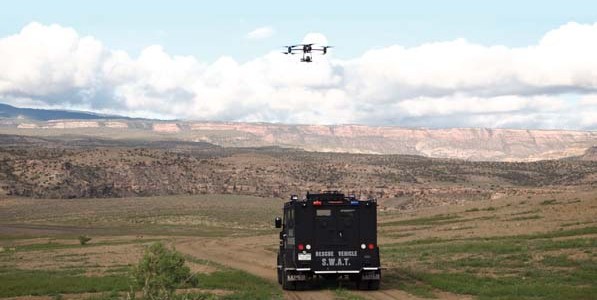The Draganfly’s quadcopters assist police
Zenon Dragan has always liked to do things that have never been done before, and back in 1998, he did just that. Back then, those interested in remote-controlled aircraft were limited to flying fixed-wing airplanes or single-rotor helicopters, which were used more for enjoyment than for any real practical purpose. That’s when Dragan, an avid hobbyist himself, decided to switch things up by designing a four-rotor helicopter known as a quadcopter — one of the first of its kind.
Above: The Mesa County SWAT team has used a Draganflyer X6 in response to immediate felonies. In one instance, after two subjects got into a car chase and collided, one subject assaulted the other with a knife and ran into the bushes. The SWAT team flew the X6 with infrared equipment to provide an overview of the area as team members searched it.
With only the Japanese company Keyese, who had manufactured a toy version of the quadcopter, as competition in this emerging field, Dragan says he instinctively knew they were on to something with huge potential and set to work on developing a quadcopter that would be able to do far more than be just a mere toy. “We started to manufacture them in 1999,” says Dragan. “We built our own carbon-fiber frames and had another company provide the circuit board for them.” But it wasn’t until they installed a wireless video camera on the unit in 2001 that the real possibilities of what a quadcopter could offer began to unfold.
“People were making rock videos with it; it was on Ripley’s Believe It or Not; there was a New York Times article written in 2002; and we even flew one live on CNN,” says Dragan. “Back then, when you were flying one of these things, people would crowd around you because they’d never seen anything like it.”
In 2004, when the company introduced lithium batteries to their design, the flight time went from five minutes to 15 minutes virtually overnight. Now the quadcopter was no longer just a fun toy. Instead, it was a practical piece of equipment, ready to be put to work, with endless possibilities.
Above: In Colorado, the Mesa County Sheriff’s Office was one of the first law enforcement agencies to attain flight authorization from the FAA. They have trained their deputies to fly a Draganflyer X6 and keep one in the back of their patrol cars for on-the-go use.
Joining the Force
Cranking out a new version each year, the company sold over 8,000 quadcopters between 1999 and 2006, when they received a request to build a quadcopter with a stabilized aerial video system for a very specific use: police work. Then it became serious business indeed.
To ready their newest unit for such a monumental task, the team at Draganfly Innovations added a host of new features, including accelerometers, gyros, magnetometers, and GPS to create the Draganflyer X6, a functional tool that has now been used by police departments across North America. Using the aircraft, departments have saved money, solved crimes, investigated accidents, and most recently, saved a civilian life — a first in the short history of rotor drones. In May 2013, Corporal Doug Green of the Saskatoon Royal Canadian Mounted Police used a Draganflyer X6 to locate a disoriented and hypothermic man who had wandered away from a highway crash in winter. “That was big news and the first time a quadcopter had ever been used to do something like that,” says Dragan. “Corporal Green even made an appearance on the Katie Couric Show to talk about it. It sparked a lot of interest and thought into how else these quadcopters can be used.”
Today, Draganflyer’s quadcopters are being used for safety inspections in a variety of industry applications for jobs that are typically dirty, dangerous, and difficult to reach (pipeline inspections, flare stack inspections, open-pit mining, geo-surveys, and power line and building inspections), and for various search and rescue needs in police work. This is especially true in Saskatchewan, Canada, where there are more multirotors in use by law enforcement agencies than in any other place in the world.
Even the agricultural industry is starting to see the value in quadcopters in what is considered the next new breakout field, where data and changes in soil and crop health can now be monitored from the air with specialized camera and surveying systems. This helps save time and money, while also removing human operators from dangerous situations.
As for the future of quadcopters, Dragan says, true to their name, his company is always looking for the next innovation. In addition to readying a new line of agriculture-related products, they’re also looking to multirotor systems to further increase stability and function. Times are changing and Dragan says that innovation is key. Having already seen a quadcopter save one life, who knows how many more can be saved or how many deaths can be prevented with this incredible little machine, once thought to be no more than a toy.
By: Gail Kesslar
Photos by: Skyreel Aerial Imaging






















